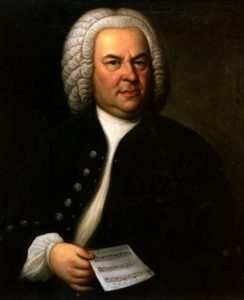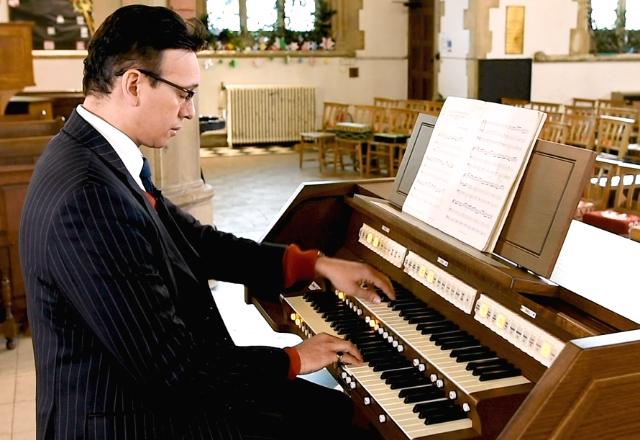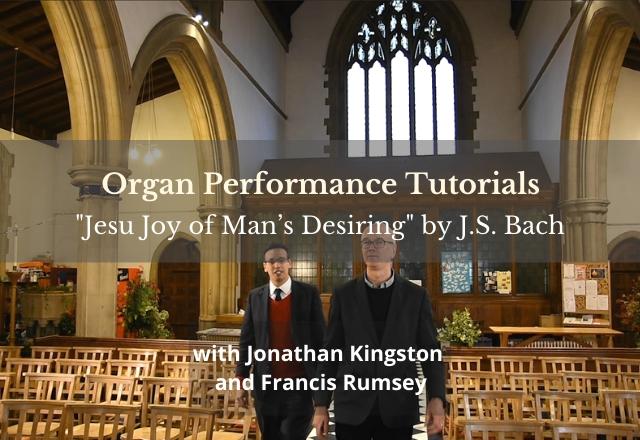The third piece in this organ performance tutorial series is Jesu Joy of Man’s Desiring by J.S. Bach. It’s a useful and relatively gentle piece that’s popular for weddings, perhaps at the signing of the registers, but could equally well be used for memorial services.
“Jesu Joy of Man’s Desiring” is a popular and widely arranged piece

“Jesu Joy of Man’s Desiring” is probably one of the most popular and widely arranged pieces in the entire musical repertoire, being based on a chorale melody originally known as “Werde Munter” written by Johann Schop. It’s a tune that’s been recycled and used in various ways by different hymn writers and composers over the years, and even the words we know today are probably based on a Victorian adaptation by Robert Bridges.
Bach’s setting of the tune for one of his cantatas (BWV 147) adds a lilting 9/8 obbligato accompaniment over and between stanzas of the chorale melody, which runs more slowly underneath. Probably one of the most famous transcriptions that popularised this was Myra Hess’s piano version in 1926.
How to perform “Jesu Joy of Man’s Desiring” on the organ
As far as performance on the organ goes, there a numerous arrangements available here too, and in this tutorial Jonathan Kingston plays one of the most straightforward—“almost stripped back to bare bones”. As he explains to Francis Rumsey during the introduction, the registration used here includes flutes at eight and four foot on the Great for the undulating accompaniment, although this could potentially be just an eight foot flute depending on the character of the organ in question.
When the chorale comes in the Swell oboe is used to give the chorale melody some prominence, combined with gentle eight and four foot flues. Pedals are simply registered as 16 and eight foot diapasons.

“Would you be tempted to vary the registration at all during the piece?” Francis asks Jonathan. “In a word, no!” he replies. There’s quite a lot going on, he suggests, even in such a straightforward arrangement, and the beauty is mainly in simplicity. The same really applies to dynamics, says Jonathan, with any interest largely being created through articulation rather than use of the swell box.
There are many other ways to go about this piece, of course, depending on the arrangement you choose and your own particular “take” on the work. Some have a more romantic approach, with a bit more dynamic variation using the swell box for example.
Whatever you choose to do, there is no “right” answer, and Bach, perhaps uniquely among classical composers, seems to tolerate many different interpretations.
Organ Performance Tutorial for Wedding and Memorial Music
The organ performance tutorials for 2020 concentrate on the playing of organ arrangements for weddings and memorial services. You can read more about this wedding and memorial tutorial series.
Our previous years’ tutorials can be found on the organ music blog or go directly to the Organ Registration Tutorial (2019) or Choral Organ Accompaniment Series (2018).
All of our video tutorials and more organ videos can be found on YouTube. Below is the playlist for the organ performance tutorial. Don’t forget to subscribe to our channel!
I have had a passion for church organs since the tender age of 12. I own and run Viscount Organs with a close attention to the detail that musicians appreciate; and a clear understanding of the benefits of digital technology and keeping to the traditional and emotional elements of organ playing.




Hello. Thank you for the enjoyable and informative video series.
With regards to Bach’s Jesu Joy of Man’s Desiring, where might one find the score for this particular arrangement?
This particular arrangement can be found on this link:
https://www.boosey.com/shop/prod/Various-Organists-Wedding-Album-vol-1/912952